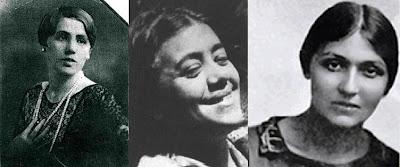 Most people mistakenly think thatYiddish literature and poetry was solely written by men. It’s unfortunate thatthis gross misconception exists, because there were hundreds of female Yiddish writersand poets, all of whom had their own distinct biographies and writing styles.
Most people mistakenly think thatYiddish literature and poetry was solely written by men. It’s unfortunate thatthis gross misconception exists, because there were hundreds of female Yiddish writersand poets, all of whom had their own distinct biographies and writing styles.Edith Kaplan Bregman was one ofthese women. She was born in a Russian shtetl in 1899 to a Hasidic family, immigratingto New Yorkwhen she was thirteen. In America,she was exposed to literature that hadn’t been available in Europe,so she became a voracious reader. Bregman went on to write poetry in her nativetongue, Yiddish. Her love of language led her to meet many Yiddish literarygiants, like Avrom Reyzen, a poet who became her mentor. While she wrote poemsthroughout her early life, her works weren’t published until 1939, when aYiddish newspaper had a poetry contest that she entered and won. Her victory gaveher the confidence to publish more of her written work. Some of the themes thatrecur throughout her poems are a love of Judaism and God, life in Europe, and Holocaust remembrance. In addition to writingpoetry, Bregman sang and played the mandolin and piano. Bregman’s last poem waspublished in 1997, a few years before her death at age 99.
Another Yiddish woman poet was CeliaDropkin (1887-1956). An eager student, she was formally educated for most ofher youth in Belarus.She began writing poetry in Russian at age ten, and was encouraged to keepwriting by Uri Nissan Gnessin, a Hebrew poet who she became close with. Aftergetting married, Dropkin immigrated to New York. She began translating her Russian poems intoYiddish and published them in several leading Yiddish literary magazines. Whilesome of Dropkin’s works were about her life experiences and children, she isfamed for her passionate poetry about sex, eroticism, love, and relationships,themes that resonate with readers today. In the early 1900s, most peoplethought that Jewish women only wrote tkhines, Yiddish prayers oftenconcerning domestic matters and childrearing; Dropkin challenged that. While anumber of critics felt that her works were too personal and too overtly sexual,her contemporaries were generally positive about her writings. Modern-dayYiddish enthusiasts have not forgotten Dropkin’s contributions to Jewishliterature, as her poems have been published in several contemporary Yiddishanthologies and set to song by klezmer bands.
Some female Yiddish poets wentout of their way to address women’s issues in their poetry. Kadya Molodowskywas one such woman. Born in 1894 in a Russian shtetl, her poetic career beganin 1920, when she published her first poem. She married and moved to Warsaw shortly afterward,where she became active in the Yiddish Writers Union. Many of her workscelebrate and discuss Jewish women and their role in the world. Her first bookof poetry, Nights of Heshvan, is written from the point of view of a Jewishwoman in her thirties who moves throughout Eastern Europe,like Molodowsky herself. It was received to wide acclaim. Another book ofpoetry, Freydke, features a narrative poem about a Jewish working-classwoman. After immigrating to New York,Molodowsky wrote From Lublin to New York: Diary of Rivke Zilberg, a bookof poems about a Jewish woman immigrant. She also wrote a column for TheForward about great Jewish women, as well as publishing a long poem aboutGracia Mendes, a Portuguese Converso who saved innumerable Jews from theInquisition. Molodowsky also cofounded and edited a Yiddish literary journal, Svive.Other themes that she wrote about are poverty, children, Judaism, the Diaspora,Zionism and Israel,and the Holocaust. Her lifetime of achievement in poetry was recognized whenshe received the Itzik Manger Prize, the most prestigious award in Yiddishliterature, in 1971.
Yiddish women poets paved the wayfor modern Jewish women writers, impacting aspiring poets from Gertrude Steinto Adrienne Rich to Vanessa Hidary. May we learn from the legacy they left usand make the world a better place because of it.

